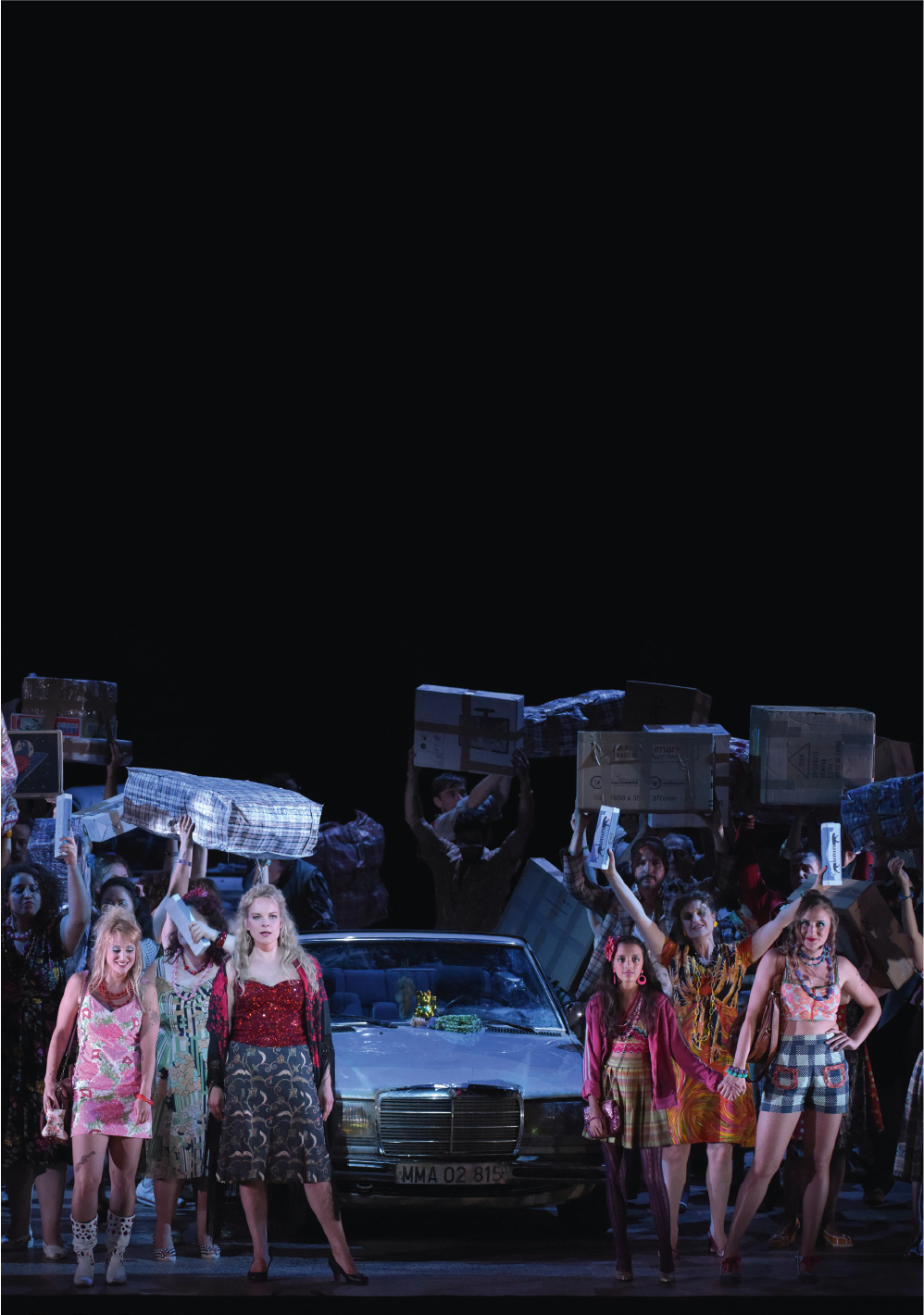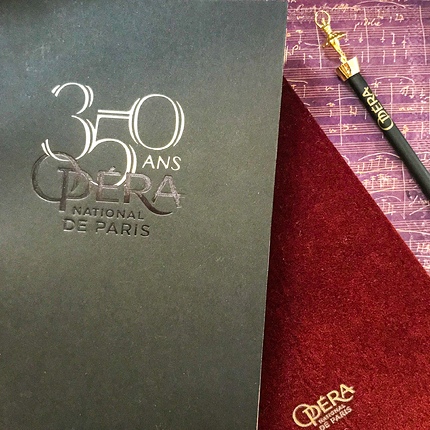The so-called “catalogue” aria is one of the most famous arias in Don Giovanni, and rightly so. Let us recall the situation: Donna Elvira, having been seduced and abandoned by Don Giovanni, is looking for him in order to exact revenge. Don Giovanni flees leaving his valet Leporello to tell her the truth (dille pur tutto). In doing so, the valet mentions a rather voluminous book (questo non picciol libro), filled with the names of his master’s conquests (è tutto pieno dei nomi di sue belle).This detail is important. He proposes that Donna Elvira read it with him (leggete com me). This act of reading, while offering some undeniably comical moments, is nonetheless marked by an extreme cruelty: Donna Elvira discovers that she is little more than an item in a long list of women who have been seduced and abandoned.
It is this particular aspect of the list that I would like to examine. The libretto of Don Giovanni uses the words catalogo then lista; these words are well-suited to the book which Leporello has before him, but not for what he actually says (or sings). Like any list, Leporello’s book contains names, specifically the individual names of the seduced women. With each new conquest by his master, Leporello adds a name to that list. However, neither Da Ponte, who wrote the libretto, nor Mozart himself, could imagine putting an interminable list of names in Leporello’s mouth. As a result, the valet does not sing what is written in his catalogue, he transforms it into something completely different, he transforms it into an inventory. The text sung by Leporello contains no individual names. Instead it uses collective names or categories (“ninety-one women” seduced in Turkey, “blondes and brunettes”). It is indeed an inventory and not a list (any list lends itself to counts and summaries in the form of inventories). The difference between the two notions is not incidental: an inventory, which is enumerated by groups, is more dehumanising than a list of names.
Both musically and narratively, the aria divides itself into two distinct moments. In the first moment, in common time, allegro, Leporello offers an initial inventory by country: 640 women seduced in Italy, 231 in Germany, 100 in France, 91 in Tukey and 1,003 in Spain (where the opera’s action takes place). The first four numbers are ranked in descending order, however, the fifth and final number is the highest of the five: The rhetorical effect is powerful. Then, still in the first part, Leporello lists the social classes that the women belong to (middle-class ladies, servants, marquises, princesses, etc.) concluding that they are of every age, rank, shape and form (d’ogni forma). This classification by category could be used to build a second inventory (how many middle-class ladies, and how many princesses?), which is only inferred. In the second moment, in 3/4 time, andante com moto, Leporello evinces a series of contrasts which evoke the physical characteristics of the women seduced: blondes or brunettes, large or small, plump or skinny, young or old. Each of these characteristics is celebrated by Don Giovanni (Nella bionda egli ha l’usanza di lodar la gentilezza, nella bruna, la costanza: Don Giovanni often praises blondes for their sensitivity and brunettes for their constancy). Are these expressions of praise used by Don Giovanni to seduce the women, in which case, in all probability, they are lies? Or are they used by Leporello, as his confident and valet, in which case they are sincere? Words of seduction or words to assume his desire? It is difficult to say. Whatever the case, the two moments of the aria contrast each other quantitatively and qualitatively as a terse, comical, yet indissolubly odious enumeration on the one hand, and a suggestion of human speech on the other (where the music becomes more tender). The transition from a binary rhythm to a ternary rhythm underlines the contrast between the two moments.
In this series of symmetries— evocative of a double entry table (a simple cross-checking of two lists), we notice dissymmetry that is both intellectual and musical. If the women, be they blonde or brunette, large or small etc. are equally coveted by Don Giovanni, the “young /old” distinction does not operate in the same way. Whilst the young woman is the object of Don Giovanni’s predilection (sua passion predominante), the old woman is seduced simply for the pleasure of including her on the list (pel piacer di porle in lista). At the very moment Leporello sings the word lista, the music modulates to a minor sixth (from D major to B flat major, B flat being the minor sixth degree of the D major scale), with the correlative modification of F sharp into F natural; and suddenly takes on a sombre tone at the very moment just as the effect of the list is explicitly enunciated and assumed—a supremely perverse effect: the conquest is no longer incited by an erotic or sensual desire, but by the rather wretched desire to add an item to his collection. The compulsion to expand a list contradicts the sincerity of the desire, repetitive desire is debased into a desire for repetition.
We are here at the very heart of the Madamina aria. Leporello’s list offers us the essence of Don Giovanni’s desire. It Is a desire which sweeps aside any differentiation between its objects. Litte matter who the coveted woman is, Spanish or Turkish, large or small, village girl or countess, all women are targets for seduction. In Da Ponte’s rather blunt libretto, two words characterise a woman: scent (mi pare sentire odor di femmina) and skirt (purché porti la gonnella). All women, in as much that they are women, are interchangeable and indistinct. The brilliant pages devoted to Don Giovanni by Kierkegaard in L’Alternative(1), analyse with acuity the reasoning behind this lack of distinction. The Danish philosopher tells us that Don Giovanni does not know how to choose and cannot choose. He is trapped in a repetitive and contradictory desire, one that is repetitive because it is contradictory: he only desires the initial stage, but what is the point of the initial stage if it doesn’t lead to anything more substantive? Don Giovanni is a man of discontinuity. This is a clear expression of the purely additive nature of the list (or the inventory, for here the distinction is irrelevant). In reality, it is by definition an asyntactic non-form. Don Giovanni existence dissolves into a sum total of conquests, a sum total that can never become a coherent and sound synthesis. The contents of Leporello’s catalogue are secondary with respect to the nature of the catalogue; the number 1,003 (Ma in Ispagna son già mille e tre), which every listener of Don Giovanni knows, is in itself irrelevant. The other numbers, fanciful as they are and whose credibility does not matter, are equally irrelevant. The only thing that matters is the act of adding and totalling and its obsessive inscription on paper.
And yet Don Giovanni remains the man of desire, seduction, deceit, irresistible sensuality; and the desire for repetition does not entirely engulf the repeated desire. In the collective conscience, Don Giovanni is first and foremost a seducer rather than a collector. The collection is secondary, the consequence of an immediate relationship to desire and conquest. It is because his desire cannot be divorced from the sphere of immediacy that Don Giovanni becomes a collector. I believe it is in this sense that Kierkegaard writes that the catalogue aria expresses “the true saga of Don Giovanni”(2). Don Giovanni's life is an endless movement, a mad saga, a race towards the abyss. This continually vanishing and continually re-emerging movement is that of the music itself: the figure of Don Giovanni is essentially musical. According to Kierkegaard, Don Giovanni is an opera character and not a theatrical one.
Don Giovanni’s desire is abstract. He desires “woman”, yet this desire
has something unreal about it, just as there is something insubstantial in the
music which so aptly expresses it. But the women whom Don Giovanni seduces and
abandons are real, and it is the father of a real woman that he kills. The
catalogue only reflects the signs of reality, and is swallowed up in the
fascination of those signs. Beyond the catalogue, reality, including the
fantastic form of the statue of the Commendatore, develops according to its own
laws until the denouement. Don Giovanni’s conquests are abstract beginnings
which, like in a dream, lead to nothing; it is reality which comes to an end in the final catastrophe, those thousands of stories that Don Giovanni never begun. In its superficially comic form, Leporello’s catalogue heralds the seducer's tragic end.
Bernard Sève is a professor of aesthetics and philosophy of art at the philosophy department of the University of Lille. He is a member of UMR 8163 “Knowledge, Texts, Language”. His published works include De Haut en bas, Philosophie des listes (Seuil, 2010), L’Altération musicale, ou ce que la musique apprend au philosophe (Seuil, 2002 et 2013) and L’Instrument de musique, une étude philosophique (Seuil, 2013).












































